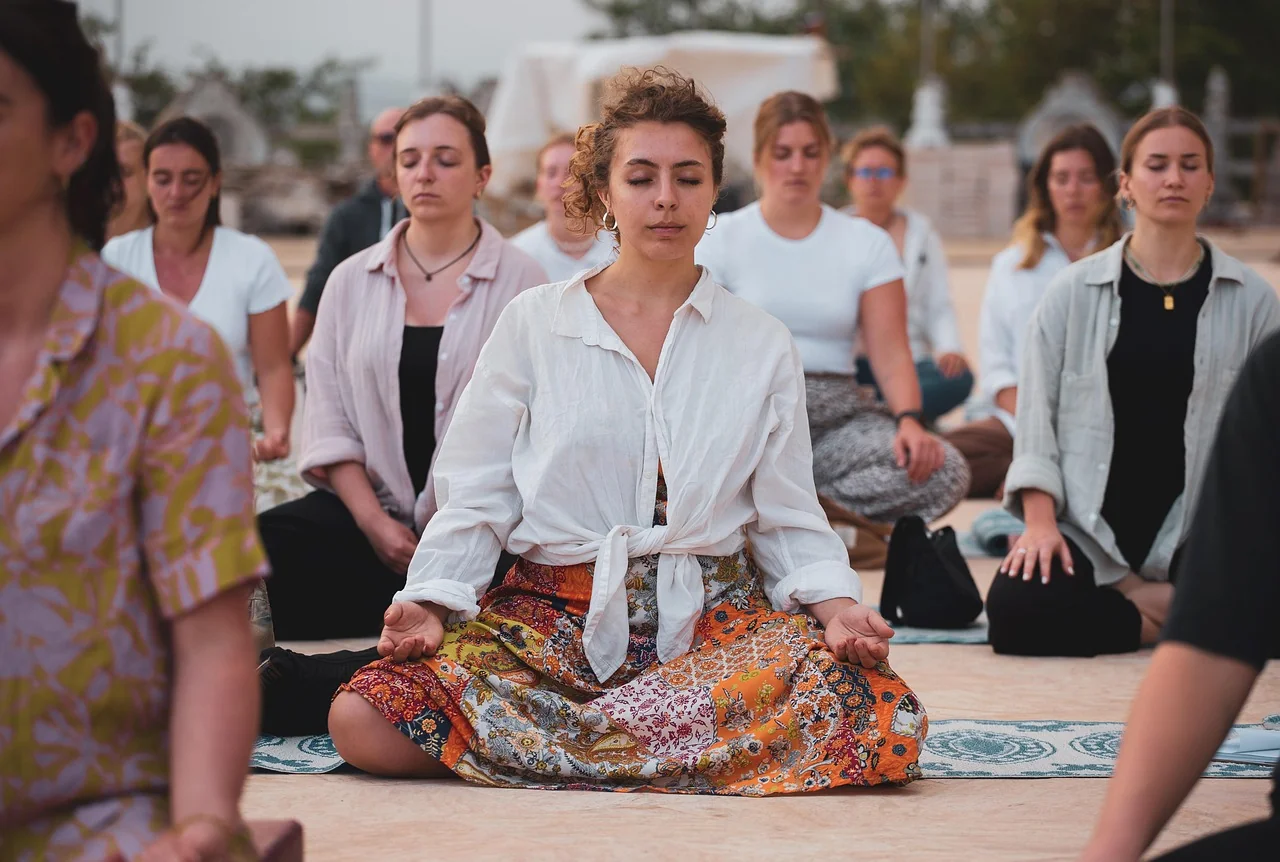Does it ever feel like you're riding in the passenger seat of your own mind? One moment you're resolved to stay calm, and the next, a wave of frustration has taken over. You set a clear goal, only to find your focus hijacked by distractions. This internal tug-of-war is the very challenge that the ancient practice of meditation for self-mastery is designed to solve.
Self-mastery isn't about suppressing who you are; it's about becoming the conscious architect of your thoughts, emotions, and actions. It’s the difference between being reactive—blown off course by every storm—and being proactive, guided by a deep, unwavering inner compass. But how do you build that kind of command? The answer lies not in fighting your mind, but in training it.
This complete guide will show you how a consistent meditation practice is the ultimate training ground for self-mastery. We'll break down the core pillars—from emotional regulation and laser-sharp focus to profound self-awareness—and provide you with practical techniques, from a simple beginner's routine to deeper methods, to help you reclaim control and unlock your highest potential.
Does it ever feel like you're riding in the passenger seat of your own mind? One moment you're resolved to stay calm, and the next, a wave of frustration has taken over. You set a clear goal, only to find your focus hijacked by distractions. This internal tug-of-war is the very challenge that the ancient practice of meditation for self-mastery is designed to solve.
Self-mastery isn't about suppressing who you are; it's about becoming the conscious architect of your thoughts, emotions, and actions. It’s the difference between being reactive—blown off course by every storm—and being proactive, guided by a deep, unwavering inner compass. But how do you build that kind of command? The answer lies not in fighting your mind, but in training it.
This complete guide will show you how a consistent meditation practice is the ultimate training ground for self-mastery. We'll break down the core pillars—from emotional regulation and laser-sharp focus to profound self-awareness—and provide you with practical techniques, from a simple beginner's routine to deeper methods, to help you reclaim control and unlock your highest potential.
What is Self-Mastery and How Meditation Unlocks It
Self-mastery is the disciplined art of directing your inner world to shape your outer reality. It’s the ability to align your daily actions with your deepest values and long-term goals, even when it’s difficult. Think of it as the ultimate form of personal freedom—you are no longer a slave to fleeting impulses, passing moods, or external distractions.
Without self-mastery, life often feels like a series of reactions. A critical email sparks anger. A tempting distraction derails an important project. A moment of fear prevents you from taking a necessary risk. You are constantly putting out fires, led by the most immediate stimulus rather than your conscious choice.
This is where meditation for self-mastery comes in. If self-mastery is the destination, meditation is the vehicle that gets you there. Imagine your mind is a muscle. You wouldn't expect to walk into a gym and lift the heaviest weight on your first day. Similarly, you can't expect to have flawless focus and emotional control without training the mental muscle responsible for it.
Meditation is that training. It’s a dedicated practice of observing your mind without judgment. Through this simple act, you begin to build the core skills of self-mastery. You learn that you are not your thoughts; you are the awareness behind them. This fundamental shift—from being lost in your experience to observing it—is the birthplace of true choice and control. This foundational mindfulness practice is the first step toward a life of inner peace and powerful intention. If you're curious about the full scope of benefits, our guide on what is meditation good for explores this in detail.
The Core Pillars of Self-Mastery Strengthened by Meditation
Meditation builds self-mastery by systematically strengthening specific mental faculties. By understanding these core pillars, you can see exactly how your time on the cushion translates into tangible benefits in your daily life.
Emotional Regulation
Before meditation, an emotional trigger often leads to an immediate, automatic reaction. You feel insulted, so you snap back. You feel anxious, so you avoid the task.
Meditation rewires this process by inserting a crucial "sacred pause" between the trigger and your response. As you practice observing your breath and bodily sensations, you become more attuned to the early physical signs of an emotion—the clenching jaw of anger, the tight chest of anxiety. You notice the emotion arising, but you don't get swept away by it. You can acknowledge, "Ah, this is frustration," and then consciously choose how to act.
This skill of emotional regulation is transformative. It allows you to respond to challenging situations with wisdom and poise, rather than being hijacked by raw feeling. It is the cornerstone of managing stress and building resilient relationships, and is a key component of achieving meditation for mental wellbeing.
Unwavering Focus and Discipline
In a world of endless notifications, the ability to focus is a superpower. Every meditation session is a rep for your focus muscle. The instruction is simple: gently bring your attention back to your anchor (like the breath) every time it wanders.
This is not a failure; it is the entire practice. Each gentle return is like a bicep curl for your concentration. Over time, this trained focus spills over into every area of your life. You find it easier to stay on task at work, listen intently in conversations, and follow through on your commitments. This cultivated mental discipline gives you the power to do what you know you should do, even when you don't feel like doing it.
Heightened Self-Awareness
You cannot change what you are not aware of. Many of our most limiting habits and thought patterns operate on autopilot, just below the surface of our conscious mind.
Meditation acts as a spotlight, illuminating this hidden terrain. Through consistent present moment awareness, you start to notice your mental loops: "I always assume the worst," or "I criticize myself constantly." This self-awareness is the first and most critical step toward self-mastery. By simply observing these patterns without judgment, you rob them of their power. You create the space to decide, "I don't have to follow that thought down its familiar, negative path." You move from being a passive participant in your inner narrative to its conscious author.
Getting Started: Your First Meditation for Self-Mastery Practice
The journey to self-mastery begins with a single, simple step. The goal here is not perfection, but consistent practice. It's far better to meditate for five minutes every day than for an hour once a month.
Here is a straightforward beginner's routine to build your foundational meditation practice.
- Find Your Spot: Choose a quiet place where you won't be interrupted. A chair or a cushion on the floor is fine. The key is to sit with a relatively straight spine, not rigid, but alert.
- Set a Time: Start small. Set a timer for just 5 to 10 minutes. You can use your phone or a dedicated meditation timer.
- Get Settled: Gently close your eyes or lower your gaze. Take two or three deep breaths to settle into your body. Notice the points of contact between your body and the chair or floor.
- Find Your Anchor: Bring your attention to the physical sensation of your breath. You might feel it most clearly at your nostrils, or in the rise and fall of your chest or abdomen. There is no need to control the breath; just observe it naturally.
- Gently Return: Your mind will wander. This is not a mistake; it is the point of the exercise. The moment you realize your attention has drifted to a thought, sound, or bodily sensation, gently and kindly acknowledge it, and then guide your focus back to the sensation of the breath. Do this without any self-criticism.
- Close with Kindness: When your timer sounds, don't jump up immediately. Slowly open your eyes. Take a moment to notice how you feel. Bring this quality of gentle awareness with you as you move into the next part of your day.
Remember, the act of noticing your mind has wandered and choosing to return to your anchor is the rep that builds self-mastery. Every return is a victory.
Advanced Techniques to Deepen Your Self-Mastery Journey
Once you have established a consistent practice with basic breath awareness, you can explore other powerful meditation techniques to target specific areas of your personal development.
Body Scan Meditation
This practice is excellent for deepening the mind-body connection and releasing stored physical tension that often holds emotional charge.
- How to Practice: Lie down on your back or sit comfortably. Bring your awareness to the toes of your left foot. Simply notice any sensations there—tingling, warmth, pressure, or even nothing at all.
- After a few moments, slowly move your awareness to the sole of your left foot, then the heel, the top of the foot, and the ankle.
- Continue this process, part by part, up your left leg, over to your right foot and leg, through your torso, back, chest, arms, hands, neck, and finally your head.
- The goal is not to change anything, but to bring a curious and accepting awareness to each region of your body. This builds profound somatic awareness, a key component of emotional regulation.
Loving-Kindness Meditation (Metta)
Self-mastery includes mastering your relationship with yourself and others. Metta meditation cultivates compassion, reduces self-criticism, and helps you manage interpersonal reactions.
- How to Practice: Begin by sitting quietly and bringing to mind someone you easily feel love for. Silently repeat a series of phrases directed at them: "May you be happy. May you be healthy. May you be safe. May you live with ease."
- After a few minutes, direct these same phrases toward yourself. This can be the most challenging part, but it is essential for self-mastery.
- Then, gradually extend the wishes to a neutral person (like a neighbor you don't know well), then to a difficult person (if you feel ready), and finally to all beings everywhere.
Observing-Thought Meditation
This is a powerful method for directly working with the thinking mind, taking self-awareness to a deeper level. For those seeking to cultivate a quieter mind as a foundation for this work, our guide on meditation for silence offers valuable insights.
- How to Practice: Instead of using the breath as an anchor, you make your thoughts themselves the object of meditation.
- Sit in a comfortable posture. As thoughts arise, imagine them as clouds passing through the vast sky of your awareness. You don't need to follow them, analyze them, or push them away.
- Simply label them gently—"thinking," "planning," "worrying"—and return to a state of open awareness. This practice creates immense distance between you and your thoughts, allowing you to see them as temporary mental events rather than absolute truths. It is the ultimate practice for de-identifying from the ego and gaining true inner freedom.
Your journey toward self-mastery through meditation is a lifelong path of discovery. It is not about achieving a perfect state of blank-minded calm, but about building a resilient, compassionate, and focused mind capable of navigating life's complexities with grace and intention. Start with the breath, be patient with the process, and trust that every moment of mindful awareness is a step toward becoming the master of your inner world.
In closing, the journey toward self-mastery through meditation is a profound and practical endeavor. By establishing a consistent practice, you cultivate the foundational skill of observing your thoughts and emotions without being controlled by them. This enhanced self-awareness is the cornerstone of emotional regulation, improved focus, and intentional living. The techniques explored—from breath awareness to loving-kindness—provide the essential tools to navigate life's challenges with greater calm and clarity. Remember, self-mastery is not about achieving perfection but about progressing in your ability to respond wisely instead of reacting impulsively. The true transformation occurs not just on the cushion, but in how you carry this cultivated stillness into every interaction and decision. Begin where you are, dedicate just a few minutes each day, and trust in the process. This path of inner discovery is the most rewarding investment you can make in yourself, unlocking a lifetime of greater peace, purpose, and personal power. Your potential for mastery awaits within the quiet moments you choose to create.


